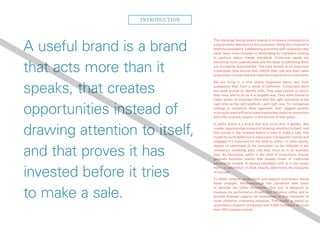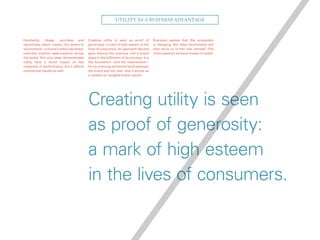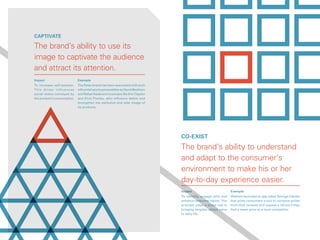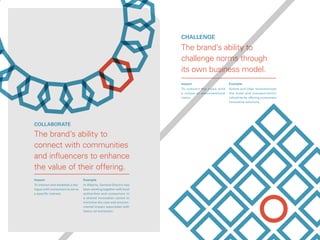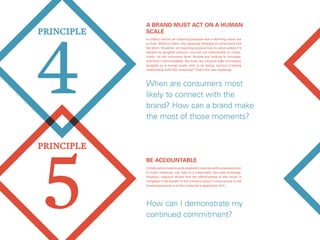The Usefulness of brands
- 1. utiThe Usefulness of Brands: The Bleublancrouge/Ipsos Barometer How can brands be relevant to consumers in 2020?
- 2. A useful brand is a brand that acts more than it speaks, that creates opportunities instead of drawing attention to itself, and that proves it has invested before it tries to make a sale. The challenge facing today’s brands is to ensure consistency in a world where distractions are constantly calling the consumer’s attention elsewhere. Establishing proximity with consumers has never been more complex or demanding for marketers looking to perform above market standards. Consumer needs are becoming more sophisticated and the ways of satisfying them are increasing exponentially. This puts brands at an important crossroads: How should they rethink their role and their value proposition in a way that will make them stand out to consumers? We are living in a time where happiness stems less from possession than from a sense of fulfilment. Consumers don’t just want brands to identify with. They want brands to enrich their lives, and to do so in a tangible way. They want brands to foster action, to empower them with the right intentions at the right time on the right platform—and right now. For companies looking to transform their approach, their biggest priority moving forward will be to make themselves useful to consumers and offer concrete support in the pursuit of their goals. A useful brand is a brand that acts more than it speaks, that creates opportunities instead of drawing attention to itself, and that proves it has invested before it tries to make a sale. The model for such behaviour is more open, transparent, human and engaged. It’s important for this shift to utility—in other words, degree of usefulness to the consumer—to be reflected in the company’s marketing plan, and even more so in its business plan. By becoming useful in the lives of consumers, brands generate business results that exceed those of traditional advertising models. A serious paradigm shift is in the works here—a redefinition of what, exactly, determines the measures of success. To better analyze, understand and support businesses facing these changes, Bleublancrouge has partnered with Ipsos to develop the Utility Barometer. This tool is designed to measure six performance drivers that influence utility, and to provide strategic support for businesses as they transition to more utilitarian marketing practices. This model is based on quantitative research conducted with 2,000 Canadians on more than 100 Canadian brands. Introduction
- 3. 60 002080 The Quest for Power The 1980s — Reinforced personal empowerment (fashion). The 1960s — Established the reign of consumer products (home appliances). The 2000s — Everything changed. The West was overcome by a fear that in turn inspired consumer awareness: the 2000s fuelled the quest for a new dream and new values (the environment). The 1970s — Saw the peak of baby boomer freedom (cars). The 1990s — In a state of pre-apocalyptic anticipation (the Y2K bug), gave rise to economic hope (online stock exchanges). the 2010s — Ushered in the age of transparency, where consumers aren’t interested in dreaming anymore. They want to understand. the 2020s — Now, early signs of things to come in the 2020s indicate that consumers will want to break free—and rule. Over time, the changing economy has affected the values, habits and moods of consumers. Nothing reflects these changes better than advertising trends. Unlike their previous search for meaning and fantasy, consumers have now set off on a search for power. They are drawn to brands that will make them feel stronger and help guide them on their quest for experiences that will forge their happiness and identity. Consumers are no longer looking to be validated by brands that reflect their personality. Instead, they are interested in brands that can increase their potential, act as catalysts for their ambition, and serve to enrich their lives or trigger change in their communities or in society at large. From here on in, utility wins out over appearance. Attracting and capturing consumer attention doesn’t do the trick anymore. Brands must aim to be useful—that’s the new starting point for both communications strategies and measurement tools. According to a 2015 study conducted by the US agency Prophet, 80% of consumers say that they are more loyal to brands that strive to be relevant in their everyday lives. This is especially true for Generation Y. In ZenithOptimedia’s recently published study, The Pursuit of Happiness, findings suggest that for brands to establish a lucrative, long-lasting relationship with this generation, they must prove to be a tangible force capable of making their lives better. If brands also play an active role in improving social structures, the trust is further secured.
- 4. Familiarity, image, purchase and repurchase intent, loyalty, the desire to recommend—a brand’s utility has direct, concrete, positive repercussions across the board. Not only does demonstrated utility have a direct impact on key measures of performance, but it affects commercial results as well. Creating utility is seen as proof of generosity: a mark of high esteem in the lives of consumers. An approach like this goes beyond the practical role a brand plays in the fulfilment of its promise. It is the foundation—and the requirement— for an enduring emotional bond between the brand and the user, and it serves as a catalyst for tangible brand results. Everyone agrees that the ecosystem is changing. But what benchmarks will best serve us in this new climate? This is the question we have chosen to tackle. Creating utility is seen as proof of generosity: a mark of high esteem in the lives of consumers. Utility as a Business Advantage
- 5. COLLABORATE CHA LLENGE CAPTIVA TE In collaboration with Ipsos, we embarked on a process to map out the various paths that ensure a brand’s utility. The tool we designed—the Utility Barometer —will serve to guide brands in creating utility for their users. Equipped with new benchmarks, brands will have the assurance they need to set out in this new marketing territory. We surveyed 2,000 Canadians to understand their relationships with the businesses in their communities, and in turn to assess the capacities of those businesses to be useful in the day-to-day lives of their customers. The Bleublancrouge/Ipsos Utility Barometer Air Canada Air France Air Transat Aldo Apple Arc’teryx Bell BNC Canadian Tire Capital One Cascades Coca-Cola Desjardins Dove Esso Ford Google Groupe Investors H&M Home Depot Honda Hudson’s Bay Huyndai Hydro-Québec IGA IKEA Intact Ïogo Irving Kellogg’s KLM Kraft L’Oréal La Parisienne Loblaws Loto-Québec Mac’s Maple Leaf MasterCard McCain Foods McDonald’s Merrell Metro Molson Mountain Coop North Face Oasis Patagonia Paypal Pepsi Petro-Canada Reitmans Rogers RONA Samsung SAQ St-Hubert Starbucks TD Telus Tide Tim Hortons Toyota Ubisoft Ultramar Vidéotron VISA Walmart Zara BRANDS CONSIDERED:
- 6. The results of this initial study uncovered some interesting issues regarding utility and enabled us to identify the challenges faced by brands looking to shift their efforts in this direction. Study scores ranged from five points for the least influential brand to 328 for the most influential. The average score was 100 points. Each score can be divided into six drivers: the guiding principles that have a positive or negative effect on utility. The Barometer produces a utility score that reflects the factors influencing consideration, recommendation, loyalty and purchase intent. Captivate MOBILIzE Co-exist Collaborate INSPIRE Challenge 0 9 % 0 % 100 330 Brand assessment utility purchase intent consideration recommendation loyalty
- 7. The brand’s ability to use its image to captivate the audience and attract its attention. Captivate The brand’s ability to understand and adapt to the consumer’s environment to make his or her day-to-day experience easier. Co-exist Exemple The Rolex brand has been associated with such influential sports personalities as David Beckham and Rafael Nadal and musicians like Eric Clapton and Elvis Presley, who influence desire and strengthen the exclusive and elite image of its products. Impact To increase self-esteem. This driver influences social status conveyed by the product’s consumption. Exemple Walmart launched an app called Savings Catcher that gives consumers a tool to compare prices from their receipts and request a refund if they find a lower price at a local competitor. Impact To identify, engage with and enhance consumer habits. This principle plays a direct role in bringing tangible added value to daily life.
- 8. The brand’s ability to rally parties in support of a cause or a fight. MOBILIze Exemple In the US, American Express initiated Small Business Saturday, an annual one-day event that brings together companies, consu- mers and public figures to support locally owned businesses. Impact To stimulate progress and foster meaningful acts by rallying various parties around social initiatives. The brand’s ability to foster innovation and change within its own industry. Inspire Exemple In an effort to support local communities and small businesses, Starbucks set the goal of getting 100% of its supplies from ethically responsible sources by the end of 2015. Impact To guide and establish itself as an opinion leader.
- 9. The brand’s ability to challenge norms through its own business model. Challenge Example In Alberta, General Electric has been working together with local authorities and consumers in a shared innovation centre to minimize the cost and environ- mental impact associated with heavy oil extraction. Impact To interact and establish a dia- logue with consumers to serve a specific interest. Example Airbnb and Uber revolutionized the hotel and transportation industries by offering consumers innovative solutions. Impact To subvert the rules with a unique or unconventional vision. The brand’s ability to connect with communities and influencers to enhance the value of their offering. Collaborate
- 10. U A brand doesn’t establish its utility by trying to stand out on every front. The challenge for brands is to look at the various drivers affecting its utility and strike a balance. It must choose, preserve, nurture and assert its position by committing to a specific central driver. The brand stance will vary according to the product or service category. The following represents an average portrait of a useful brand, by driver, in Canada: The 2015 edition of the Barometer reveals five fundamental lessons and five questions that are likely to trigger a shift towards utility. Early Lessons Success requires an anchor Where is my utility anchored? In which of these sectors will my utility be most natural and believable? 1 PRINCIPLE MobilizE 12% Co-exist 24% Challenge 3% Inspire 22% Collaborate 9% Captivate 31%
- 11. 3 PRINCIPLE 2 PRINCIPLE Problem-solving is key The trick isn’t to establish a relationship at all costs. It’s important for brands to un- derstand the lifestyle of their consumers and adapt accordingly rather than invade their space. Brands that co-exist with their consumers make their daily lives easier. It’s not sur- prising that co-existence has the most direct and noticeable impact on a brand’s usefulness, as it is, in essence, the cornerstone of utility. Consumers naturally gravitate towards brands that understand how to act on their behalf and how to mesh with their daily lives. They are looking for brands that connect with their passions and needs, and stimulate their interests in relevant ways. How does a brand that co-exists distinguish itself in a tangible way? By creating tools. By developing services that are central to its offering or that complement it. In so doing, the brand shows its commitment to resolving an issue in the daily lives of consumers. Beyond the transaction, what impact can a brand have on the everyday lives of consumers? Captivation has its limits How can my knowledge or area of expertise foster change? Envy and desire are no longer the criteria when it comes to creating a lasting connection with consumers. It’s time to move on. The concept of captivation is a double-edged sword. Brands need to gain visibility and exposure, but captivation must be offset by tangible, proven and lasting commitments to consumers. For example, in addition to generating desire, Nike backed this up with a lasting connection by developing tools to bring tangible utility to consumers depending on their relationship with the brand—from Nike Fuel to help runners track their activity to the Makers app to show designers what materials are more sustainable. That’s how a brand affirms its purpose and relevance in the marketplace.
- 12. 5 PRINCIPlE 4 PRINCIPlE Be accountable Collaboration helps brands establish close ties with consumers and, in some instances, can lead to a meaningful two-way exchange. However, research shows that the effectiveness of this driver is mitigated if the benefit of the initiative doesn’t come across in the brand experience or in the consumer’s application of it. How can I demonstrate my continued commitment? A brand must act on a human scale When are consumers most likely to connect with the brand? How can a brand make the most of those moments? In today’s world, an inspiring purpose and a defining vision are a must. Without them, any gestures directed at consumers will fall short. However, an inspiring purpose has no value unless it’s backed by tangible actions—carried out individually or collec- tively—at the consumer level. Brands are looking to innovate, and that’s commendable. But how can a brand make innovation tangible on a human scale, and, in so doing, nurture a lasting relationship with the consumer? That’s the real challenge.
- 13. A number of studies have looked at utility, but few have focused on the tools that a brand can leverage to optimize its marketing performance. The Barometer offers an interesting diagnosis and goes one step further, outlining the solutions marketing managers need if they want to master utility and take effective action, without losing sight of consumer expectations. People don’t buy products anymore. They buy an ideal. In this context, the Barometer is a starting point for a more extensive, substantial conversation about the new tools we can implement to create applied and lasting value—both for brands and for consumers. This is only the beginning People don’t buy products anymore. They buy an ideal. Simon Cazelais Vice-President, Client Services scazelais@bleublancrouge.ca bleublancrouge.ca/blogue To continue the discussion, visit:


